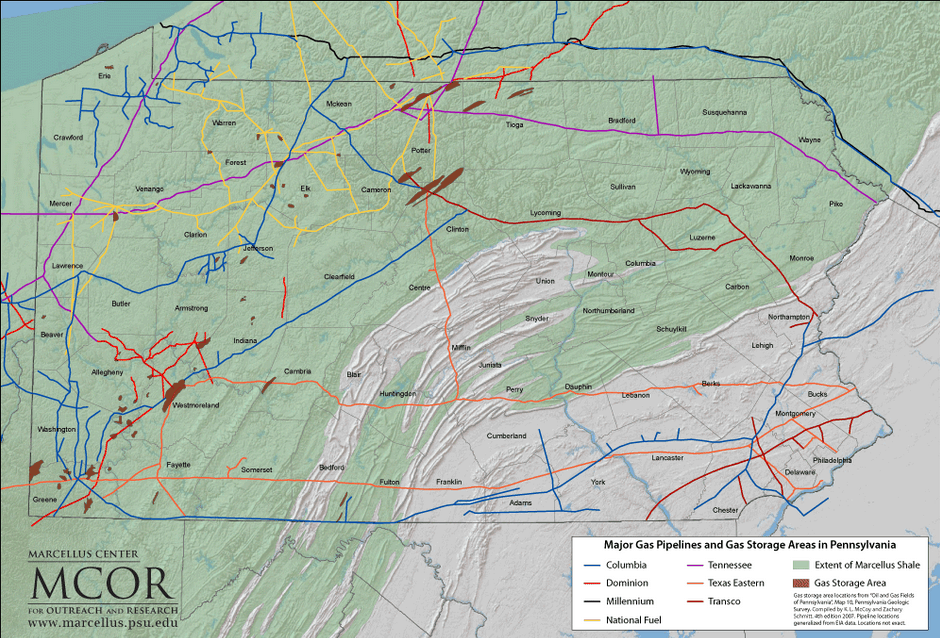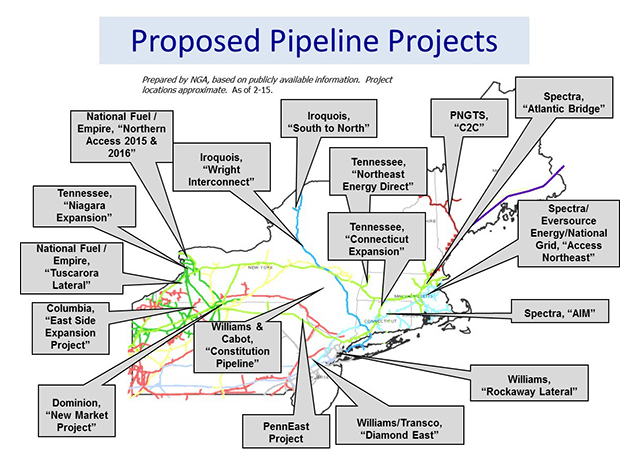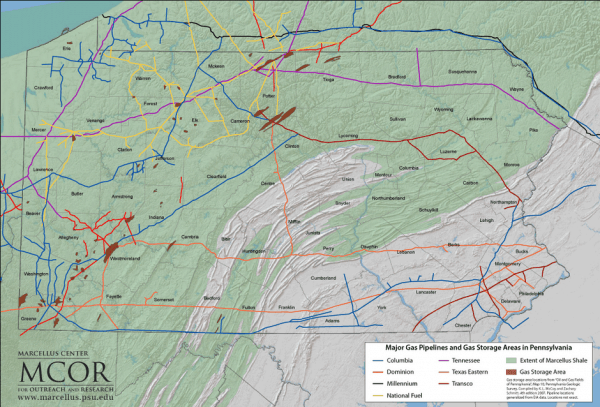For the past few blogs, I have been drawn towards writing about the Marcellus Shale. I just cannot get enough of this ever increasing natural gas producing shale play! Well, guess what folks? I got the chance to visit Pennsylvania last week to see what all the hype is about and of course visit some of our clients. One of the first things I saw upon stepping off the plane, was a billboard advertising liquid natural gas. Once we got into the car and headed down the highway, it was billboard after billboard of either a natural gas company, pipeline, production, etc. Yup…I have arrived at the right place!
One thing that seemed to be a common topic when meeting with the oil and gas companies were existing and upcoming natural gas pipelines. Due to the Marcellus shale’s increasing natural gas production and producing about 16 percent of what the entire U.S. consumes annually, there has been a high need for pipeline growth and expansion. In the Marcellus, there are nine existing pipelines and five proposed pipelines/projects. The proposed projects are to help transport natural gas from the Marcellus to other areas of the country.
Some existing major pipelines that run through the Marcellus are:
Columbia Gas Transmission: 12,000 miles long spanning 10 states bring gas from the gulf to the Marcellus
Tennessee Gas Pipeline: 13,900 miles long spanning from Gulf of Mexico, Louisiana, and S. Texas to the Marcellus.
Texas Eastern Transmission: 8,987 miles long spanning from Gulf Coast to Marcellus.

Transco: This pipeline has been in operation since the 1950s. It is 10,200 miles long from S. Texas running through the Northeast to New York City delivering about ten percent of the nation’s natural gas. This pipeline is actually the largest pipeline in the United States by volume. In Virginia alone, the pipeline is 850 miles and delivers ¼ of Virginia’s consumable natural gas. Williams, which is the operator of Transco Pipeline, is currently working on an expansion of Transco that would be able to move two billion cubic feet of gas per day. This expansion is called the Appalachian Connector Project and should be operating by late 2018.
Natural gas production in the Marcellus has continually increased and is the leading region in the U.S. for gas production. With the growing need and demand of gas distribution in the Marcellus there has been many proposed projects and pipeline expansions. Some proposed projects include:
Constitution Pipeline: 124-mile pipeline designed to transport natural gas from Pennsylvania to the Iroquois Gas Transmission and Tennessee Gas Pipeline in New York. The Constitution Pipeline is planning to begin construction in summer 2015 and begin service by end of 2016. According to constitution pipeline, this project is expected to generate $17 million in new sales and income tax revenue. Constitution Pipeline would also be considered an “open access pipeline.” What this means is that local cities or public utilities would be able to tap the pipeline to be able to deliver residential, commercial and industrial gas service.
Leidy Southeast Expansion: This project is designed to be able to increase the current Transco pipeline capacity by over 4 million gallons per day. The expansion would consist of about 30 miles of additional pipeline in Pennsylvania and New Jersey.

East Side Expansion project: The project will be the addition of two pipelines. One being 9.5 miles from New Jersey and 9.5 miles in Pennsylvania. This project is for the intent of increasing pipeline capacity through existing pipeline connections. This project is to be in service by fall 2015.
It is exciting to see the rapid growth and development of the Marcellus Shale over the past few years. Especially since CROFT is part of the natural gas industry, I couldn’t help but get a little excited when I saw all the natural gas advertisements when I was in Pennsylvania. Some of the companies we had met with had expressed the need for more developments of pipelines so I was interested to see what projects are in the mix to help making that happen. The way the Marcellus is headed, I am sure there are many more expansions and projects to come.
We want to be sure we help with any gas processing needs. With the Marcellus growing, natural gas processing is also growing. Feel free to check out CROFT’s product line. Oh! Did I mention that our dehydration system requires no air permits?! To find out why that is a big deal for the Marcellus region…that is another blog topic for a later date. Stay tuned!
http://co.williams.com/expansionprojects/appalachian-connector/
http://www.naturalgasintel.com/marcellusinfo
http://www.kindermorgan.com/business/gas_pipelines/east/TGP/
http://www.spectraenergy.com/Operations/US-Natural-Gas-Pipelines/Texas-Eastern-Transmission/
http://co.williams.com/operations/atlanticgulf-operations/transco/












